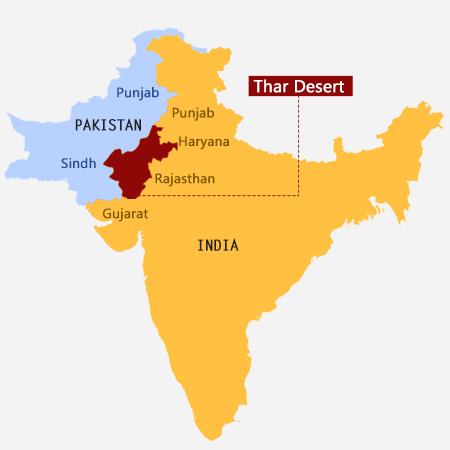
All are aware of the Thar desert that spans parts of western India and eastern Pakistan. However, there are some interesting facts about this desert that many may love to know.
Did you know?
Covering about 60% of the Indian state of Rajasthan, the Thar Desert has become the biggest wool-producing area in India with almost 40-50% of India’s total wool production coming from this region.

Also known as the Great Indian Desert, the Thar desert extends over 77,000 square miles enclosing Eastern Pakistan and parts of Northwestern India. A major portion (about 85%) of this desert is spread over the Indian states of Rajasthan, Haryana, Punjab, and Gujarat.
The rest lies in the Pakistani states of Sindh and Punjab. It is believed to be the seventeenth largest desert and the ninth largest subtropical desert in the world.
Some Interesting Facts
Inhabitants and their Occupation
The Thar desert, having a population density of 83 people per square kilometer is the most densely populated desert in the world.
Animal husbandry and agriculture are the primary occupations of the people living in this desert region. The popularity of animal husbandry has increased since the extreme climatic conditions make farming difficult. Due to this, the animal population has also increased to a great extent, which in turn has caused overgrazing that further affects the climatic and drought conditions of the region.
Kharif crops are the chief source of agricultural production, bajra being the main crop. The other crops include corn, jowar, groundnuts, sesame, etc.
The generation of electricity from wind power is carried out in the Thar desert―it is considered to be an ideal place for the same.
The annual precipitation of this arid region is in the set range of about 3.9 to 19.7 inches, mostly occurring in the months from July to September.
Wildlife and Other Species
The Thar desert is known for its diversified habitat and ecosystem, inhabiting wild species that are diminishing in most deserts of the world. The species include chinkara or Indian gazelle, the Great bustard, and the Indian wild ass, present in good numbers in this region.
The Blackbuck species is also found in this region. Other species like snakes, caracal, lizards, etc., are also found here. Moreover, it is believed that this region inhabits 23 species of lizards and 25 species of snakes.
This desert supports and provides shelter to 141 bird species which include falcons, eagles, buzzards, vultures, etc. One can even find the Indian Peafowl species in this region.
The cattle population in the region include sheep, goats, camels, cows, buffaloes, etc.
Camels are popular in this region, may it be in the case of Desert Safaris that attract tourists, or the major role they exhibit in the Desert Festival.
Water Sources and Irrigation
Originating in the Pushkar Valley of the Aravalli Range, the only natural source of water in this region is believed to be the Luni River ending in the Rann of Kutch (Gujarat).
The Rajasthan canal system is believed to be the world’s largest canal irrigation system that is being extended with an aim to enable cultivation in the desert region.
Vegetation
In spite of the arid conditions of this region, it supports dense vegetation comprising a variety of trees, shrubs, herbs, and grasses. Balanites roxburghii, Ziziphus zizyphus, Lycium barbarum, Capparis decidua, etc., are some of the trees and shrubs species, while Cenchrus biflorus, Panicum antidotale, Cenchrus ciliaris, Citrullus colocynthis, etc., are some species of herbs and grasses.
A tree species named Prosopis cineraria found in this region has great importance as it is the source of livelihood to the residing communities. The wood from this tree is mainly used for various construction purposes, such as building of houses, doors and windows, rafters, etc. It has also gained importance as a fodder tree.
Tecomella undulata is another tree species, known as the main source of timber in the region as well as for its medicinal properties.
The aforementioned facts may have helped you gain an overall insight of the Thar desert, and the lifestyle and other conditions prevailing in the region.













